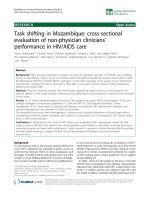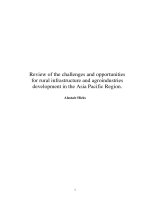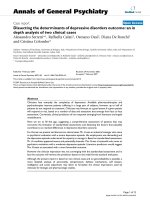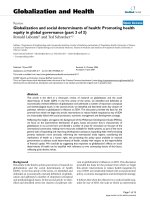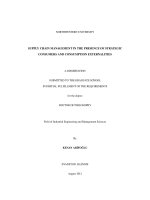Determinants of adidass supply chain performance in asia pacific region
Bạn đang xem bản rút gọn của tài liệu. Xem và tải ngay bản đầy đủ của tài liệu tại đây (411.3 KB, 60 trang )
MINISTRY OF EDUCATION AND TRAINING
UNIVERSITY OF ECONOMICS HOCHIMINH CITY
---------
Nguyễn Mỹ Phước
FACTORS AFFECTING
CONSUMERS’ RE-PURCHASE INTENTION
TOWARDS RETAIL BANKING SERVICES
IN VIETNAM
MASTER THESIS
Ho Chi Minh City, 2011
MINISTRY OF EDUCATION AND TRAINING
UNIVERSITY OF ECONOMICS HOCHIMINH CITY
---------
Nguyễn Mỹ Phước
FACTORS AFFECTING
CONSUMERS’ RE-PURCHASE INTENTION
TOWARDS RETAIL BANKING SERVICES
IN VIETNAM
Major: Business Administration
Code: 60.34.05
MASTER THESIS
Supervisor: Nguyễn Thị Mai Trang
Ho Chi Minh City, 2011
ACKNOWLEDGEMENT
First of all, I would like to express my deep appreciation to my supervisor Dr.
Nguyen Thi Mai Trang, a respectable, responsible and resourceful scholar, who had
read and re-read my work repeatedly, thanks her for all the patience, valuable
guidance, and perspectives throughout the research. Without her exceptional support,
I could not have completed my thesis.
I wish to express my appreciation Dr. Tran Ha Minh Quan, my head teacher, for his
encourages.
Thanks and love in abundance to my parents, who provided much support in
everything.
I would like also thank all my best friends who had assisted and supported me,
especially in valuable research database, data collection process.
ABSTRACT
With the intense competition and increasing globalization in the financial markets,
bank management must develop customer-oriented strategies in order to compete
successfully in the competitive retail-banking environment. The longer a bank can
retain a customer, the greater revenue and cost savings from that customer. However,
customers are also more prone to changing their banking behaviour when they can
purchase nearly identical financial products provided by the retail banks. In order to
stay competitive, bank managers need to understand the factors that influence and
determine bank consumers’ re-purchase intention.
Purpose: This study identifies and analyses the factors that influence bank
customers’ re-purchase intention in the Vietnamese retail banking industry.
Methodology: Sampling technique is used to select the respondents from some banks
in Ho Chi Minh City. Multiple regression analysis was used to identify relationship
between independent variables (convenience, service quality, competitiveness of
price, reputation and tangibles) and the dependent variable (bank customers’ repurchase intention).
Findings: The findings reveal that Convenience, Service quality, Competitiveness of
price, and Reputation have an impact on bank customers’ re-purchase intention.
Practical implications: In general, the results of this research allow service
marketers to develop and implement services marketing strategies to increase bank
customers’ re-purchase intention rates, and in turn, increase bank profits.
Keywords: Convenience, Service quality, Competitiveness of price, Reputation and
Tangibles, Bank customers’ re-purchase intention, Retail banking services, Vietnam.
GLOSSARY
Automated teller machine (ATM). A special device that allows customer to make
debit transactions for electronic payment and delivers cash.
Phone Banking. Banking services that allow a customer to interact with a financial
institution from a remote location by using a telephone (Telephone banking or Telebanking).
Internet banking. Systems that enable bank customers to access accounts and
general information on bank products and services through a personal computer (PC)
or other intelligent devices.
Table of Contents
List of Figures .................................................................................................................................................... i
List of Tables ..................................................................................................................................................... ii
CHAPTER 1: INTRODUCTION...................................................................................................................... 1
1.1
Research background ....................................................................................................................... 1
1.2
Problem statement ............................................................................................................................ 3
1.3
Research objective .......................................................................................................................... 4
1.4
Scope and Research methodology ................................................................................................... 4
1.5
The structure of the research ............................................................................................................ 4
CHAPTER 2: LITERATURE REVIEW.......................................................................................................... 6
2.1 Bank customers’ re-purchase intention ................................................................................................... 6
2.2 Convenience ............................................................................................................................................ 7
2.3 Service quality......................................................................................................................................... 8
2.4 Competitiveness of price ......................................................................................................................... 9
2.5 Reputation ............................................................................................................................................. 11
2.6 Tangibles ............................................................................................................................................... 12
Research model ........................................................................................................................................... 12
CHAPTER 3: RESEARCH METHODOLOGY ............................................................................................ 14
3.1 Design and sample................................................................................................................................. 14
3.1.1 Qualitative survey .............................................................................................................................. 14
3.1.1.1 Qualitative survey procedure ................................................................................................... 14
3.1.1.2 Results of the focus group ....................................................................................................... 15
3.1.2 Quantitative survey ............................................................................................................................ 15
3.2 Sample size ............................................................................................................................................ 16
3.3 Measurement ......................................................................................................................................... 17
3.4 Data processing and analysis method .................................................................................................... 18
3.5 Summary ............................................................................................................................................... 20
CHAPTER 4: RESULTS AND DISCUSSION .............................................................................................. 21
4.1 Description of sample ............................................................................................................................ 21
4.2. Assessment of scale .............................................................................................................................. 22
4.2.1 Reliability testing ............................................................................................................................... 22
4.2.2 Exploratory Factor Analysis (EFA) ................................................................................................... 25
4.3 Research hypothesis testing ................................................................................................................... 27
4.4 Summary............................................................................................................................................... 29
CHAPTER 5: CONCLUSIONS AND RECOMMENDATION ..................................................................... 30
5.1 Conclusion ............................................................................................................................................. 30
5.2 Research implications............................................................................................................................ 30
5.2.1 Theoretical implications ..................................................................................................................... 30
5.2.2 Managerial implications ..................................................................................................................... 31
5.3 Limitations and further research recommendation ................................................................................ 33
References ....................................................................................................................................................... 35
APPENDICES ................................................................................................................................................. 38
Appendix 1: Survey Questionnaire (in Vietnamese) ................................................................................... 38
Appendix 2: Survey Questionnaire (in English).......................................................................................... 40
Appendix 3: Reliability of Convenience ..................................................................................................... 42
Appendix 4: Reliability of Service Quality ................................................................................................. 43
Appendix 5: Reliability of Competitiveness of Price .................................................................................. 44
Appendix 6: Reliability of Reputation ........................................................................................................ 45
Appendix 7: Reliability of Tangibles (before deleting TAN3 item) ........................................................... 46
Appendix 8: Reliability of Tangibles (after deleting TAN3 item) .............................................................. 47
Appendix 9: Reliability of Consumers’ Re-purchase Intention .................................................................. 48
Appendix 10: Pearson correlation coefficient ............................................................................................. 49
List of Figures
Figure 1.1: Vietnam’s banking market is in an early stage of development ..........................2
Figure 2.1: Research model......................................................................................................13
i
List of Tables
Table 3.1: Guidelines for focus group interview .....................................................................15
Table 3.2: Findings from the focus group interview ................................................................15
Table 3.3: Description of factors ............................................................................................157
Table 4.1: Sample description statistic.....................................................................................22
Table 4.2: Reliability statistic and items – total statistic of components ...............................264
Table 4.3: Rotated Component Matrix.....................................................................................26
Table 4.4: Model Summary....................................................................................................267
Table 4.5: Coefficients of independent variables ...................................................................278
Table 4.6: Summary of hypotheses testing results .................................................................288
ii
CHAPTER 1: INTRODUCTION
1.1 Research background
In recent years, the growth of Vietnam financial services sector has been gone up
significantly. On lending side, “the four large state-owned commercial banks —
Vietnam Bank for Agriculture and Rural Development (Agribank), Bank for
Investment and Development of Vietnam (BIDV), Bank for Foreign Trade of
Vietnam (Vietcombank) and Vietnam Bank for Industry and Trade (Vietinbank) —
continue to dominate Vietnam’s banking system, accounting for 51% of systemwide loans at end-September 2009 (2008: 52%; 2007: 54%). They very actively
distributed two-thirds of all loans at subsidised interest rates and thereby defended
their market shares. The two largest privately owned banks — Asia Commercial
Bank (ACB) and Sacombank — recorded exceptionally brisk loans growth in first
nine months 2009 (un-annualised): 78% and 62%, respectively.” (Fitch Ratings,
2010)
Under World Trade Organization rules, Vietnam has to open the economy,
including financial services, to global competition. International banks have looked
forward to enter into Vietnam’s young and potential market. Consequently, not only
competition has become higher in this sector, but also consumer has more options
for their financial services needs.
However, “Vietnam is largely undeveloped territory for banking services. Out of a
total population of 84 million people, just 5 million have a personal bank account,
and only 2% have ever taken out a bank loan. Even in the biggest cities, consumers’
use of bank services is still rare. Only about half of Hanoi’s residents and than a
third of those living in Ho Chi Minh City have bank accounts. City dwellers are
eager to embrace modern financial products. The number of credit card holders has
jumped 300% since 2004, to some 2 million, and demand for loans to finance the
1
purchase of motorbikes, cars and apartments is heating up” (Edmund, Sunny, and
Shinji, 2007).
Figure 1.1: Vietnam’s banking market is in an early stage of development
Adoption
Growth
Saturation
Singapore
Taiwan
Japan
Australia
Philippines
Vietnam
India
Indonesia
Thailand
China
Malaysia
Korea
Source: Swiss Re Sigma Report 2006; Population Research Bureau; Lit. Searches; Bain Analysis
Note: Bank assets data for Taiwan, Indonesia and Philippines are for 2003; X-axis is not to scale
Furthermore, loan outstanding in Vietnam is mainly from corporate borrowers.
Personal loans are still a small number. Moreover, only a small percent of
population has bank account. As a result, the potential for personal consumers is
very big.
With the lowering of entry barriers and blurring product lines of banks and nonbanks since the financial sector reforms, banks are functioning increasingly under
competitive pressures emanating from within the banking system, from nonbanking institutions and from the domestic and international capital markets. In this
era of mature and intense competitive pressures, it is imperative those banks
maintain a loyal customer base. In order to achieve this and improve their market
and profit positions, many retail banks are directing their strategies towards
increasing customer satisfaction and loyalty through improved service quality,
competitiveness of price, etc. In the present competitive Vietnamese banking
2
context, characterized by rapid change and increasingly sophisticated customers, it
has become very important that banks in Vietnam determine factors, which are
pertinent to the customers’ selection process. This is because if services dimensions
can be identified, bank managers should be able to improve the delivery of
customer perception of quality during the service process and have greater control
over the overall outcome.
1.2 Problem statement
The world has been recovering after the global financial crisis happened in 2007.
Like other countries, Vietnam economy has been affected at a certain level under
this crisis. Around the world, many firms and banks have lost ability to pay their
debts and gone bankrupt. The crisis also has it effects on consumer not only their
jobs, finance, etc but also decrease of their confidence level in the economy.
Consumer behaviour in all industries generally and particularly financial sectors has
been changed significantly after the crisis.
In the academic world, there is many research conducted to study various issues in
service marketing, including consumer behaviour towards services. Numerous
studies have shown that banks’ profitability is closely associated with customer
repurchase intention (Garland, 2002; Anderson et al., 1994). The longer a bank can
retain a customer, the greater revenue and cost savings from that customer.
Maintaining an existing customer is five times cheaper than obtaining a new one as
the advertising, sales, and set-up costs can be amortised over a longer customer
lifetime. Duncan & Elliot (2002) note that customer loyalty is an important factor
that contributes to an organization’s earnings and profits. Loyal customers normally
establish a stable relationship with an organization compared to non-loyal
customers (Zeithaml et al., 1996). Customer loyalty can contribute to an increase in
a firm’s revenue; reduce customer defection rates. Thus, at the end of the day, the
3
bank’s assets are not only primarily registered on the balance sheet, but also related
to the fact that customers have been successfully retained.
1.3 Research objective
The objective of the research is to examine key factors such as Convenience,
Service Quality, Competitiveness of Price, Reputation, Tangibles and their
influences on Customers' Repurchase Intention in banking services.
1.4 Scope and Research methodology
The survey was carried out in Ho Chi Minh City, which is not only the most
developed city in Vietnam but also the most crowded one of Vietnam. Qualified
respondents for this study are individuals who used or have used services in
commercial banks.
After determining a set of variables from literature review, focus group helps to
create a relevant list of major factors affecting bank customers’ re-purchase
intention. Through the pilot test, the questionnaire was modified to make clearer
and understandable for respondents. The questionnaires were distributed directly to
200 qualified respondents. The SPSS 16 for Window was used for data processing
and analysis. Cronbach alpha was used to measure internal reliability. Factor
analysis was designed to simplify the correlation matrix and reveal a small number
of factors which can explain the correlation; therefore, it was used in this study
to test items for convergent validity and uni-dimensionality. Multiple linear
regression (MLR) was used to test the research hypotheses.
1.5 The structure of the research
The thesis is organized in five chapters. Chapter one presents the introduction of the
thesis including research background, problem statement and research question,
research objectives. Research methodology, scope and the structure are also
4
mentioned. Then, chapter two reviews the literature relating to factors affecting on
bank customers’ re-purchase intention which are examined in this study. Based on
the literature review, a list of hypotheses is proposed. Chapter three describes the
data and methodology of the research. Chapter four presents results and discussion.
Finally, the last chapter presents the major findings of the research, managerial
implication and as well as recommendations.
5
CHAPTER 2: LITERATURE REVIEW
This chapter begins with an overview of key factors effecting customers’ repurchase intention and hypotheses. Then it continues with a specific research
model.
In financial services, the issue of the key factors effecting consumers’ bank
selection has been researched a lot by many researchers in many countries. There
are studies conducted in the USA such as of Khazeh and Decker (1992), Stafford
(1996) and Boyd (1994) and so on. More research carried out in other countries, in
Swiss, Canada, Turkey, Poland, Bahrain, etc.
Most of the previous studies the investigators used a broad and in most cases
different set of bank. It found that of convenience, service quality, competitiveness
of price, and reputation of the bank, are coming back in most of the studies.
Although tangibles were evaluated low in most previous research, it still has
significant importance (Safiek, 2009). In this study, these dimensions are used to
predict bank customers’ re-purchase intention towards Vietnamese banking
services.
2.1 Bank customers’ re-purchase intention
Repurchase intention is defined as the customers’ decision to engage in future
activity with a service provider. In banking sector, banking consumers’ purchase
intentions were indicators, which showed whether customers had remained with or
had defected from banks (Zeithaml et al., 1996). A bank’s ability to attract and
retain new customers, is not only related to its product or services, but strongly
related to the way it services its existing customers and the reputation it creates
within and across the marketplace (Garland, 2002). Customer re-purchase intention
is more than giving the customer what they expect; it is about exceeding their
expectations so that they become loyal advocates for your brand. Creating customer
6
re-purchase intention puts customer value rather than maximizing profits and
shareholder value at the center of business strategy. Bank customers’ re-purchase
intention is understood as saying positive things to other people and the customers’
decision to use services with a bank (Zeithaml et al., 1996).
2.2 Convenience
Convenience refers to the degree of a customer’s perception of the time and effort
required to reach a service provider. Although the bank selection criteria are
different, the results of the studies suggest that convenience is the primary
determinant in bank selection (Stafford, 1996, Almossawi, 2001). In banking
services, convenience is understood as place and time of transaction, such as
convenient location of the bank’s branches, ATM network, internet and phone
banking services and long opening hours of the bank, several of branches (Safiek,
2009; Huu and Kar, 2000).
Location has special meaning in the financial service industry because it is at the
branch or office that banks and the customer are connected; it is where the
customers have their accounts. Reichheld & Sasser (1990) suggest that a convenient
bank location is an important factor influencing customers’ re-purchase intention
behaviour because it directly determines whether the customers can access their
banks on a regular basis. Moreover, Gerrard & Cunningham (2004) investigated the
bank switching behaviour of Singapore’s graduates and find that inconvenience is
the most important switching factors.
In conclusion, convenience is an important factor in guiding customers to choose
banks. Geographical inconvenience has a negative impact on customers who want
their banking services to be delivered on a face-to-face, personal basis (Gerrard &
Cunningham, 2004). In contrast, convenience can encourage customers to stay at
their current bank and delay the idea of switching, even if the satisfaction rate is not
high (Lee & Cunningham, 2001). Therefore, the following hypothesis is proposed:
7
H1: There is a positive relationship between Convenience and bank Consumers’
Re-purchase Intention.
2.3 Service quality
Service quality is defined as a customer's overall impression of the relative
inferiority or superiority of the organisation and its service provisions. Lewis et al.
(1989) define service quality as a measure of how well the service level delivered
matches customer expectations. Perceived service quality is developed from the
perspective of a customer’s attitude to judge the overall service prevision. Lewis et
al. (1989) suggests perceived service quality is a consumer judgement which is
derived after comparing consumers’ expectations of service with their perceptions
of actual service performance. In general, customer expectations can be established
from pervious experiences with the organisation, the competitors of an organisation,
the traditional marketing mix, or external influences such as word-of-mouth
communication (Parasuraman et al., 1988). In regards to banking, Kamilia and
Jacques (2000) note that perceived service quality results from the gap between
customers expectations of the service provided by the bank and the perception of
the actual services provided by the bank.
Many researches find that service quality is related with customer satisfaction which
can lead to behaviour consequence. For example, Bloemer et al. (1998) identify that
service quality can directly and indirectly effect customer satisfaction, and that
satisfaction has a direct effect on bank customer loyalty. Levesque & McDougall
(1996) point out that service problems and the bank's service recovery ability have a
major impact on customer satisfaction and customers’s intentions to switch banks.
In most of the previous research, the service level is an important criterion for
consumers when selecting a bank (Almossawi, 2001).
Moreover, Lewis & Soureli (2006) investigated the antecedents of customer loyalty
in retail banking and summarize that service related factors, such as speed of
8
delivery, efficiency, friendliness, ease of contact and frequent communication can
favourably assist banks to enhance customer loyalty. The authors’ study reveals that
the customers who perceived higher standards of service quality than their
expectations are normally satisfied and appear to be loyal toward the bank. Leeds’s
(1992) study shows that nearly half of the customers switch banks because of poor
services. In addition, Leeds also shows that improving service quality can increase
customers’s re-purchase intention. Similar research by Zeithaml et al. (1996)
confirms that favourable behavioural intentions can be determined by good service
quality. Furthermore, high service quality can enhance reputation, increase
customer re-purchase intention, attract new customers through word-of-mouth,
generate repeat sales, create competitive product difference, and improve financial
performance & profitability of the firms (Zeithaml et al., 1996).
Therefore, the following hypothesis is proposed:
H2: There is a positive relationship between Service Quality and bank Consumers’
Re-purchase Intention.
2.4 Competitiveness of price
Price is an attribute that must be given up or sacrificed to obtain certain kinds of
products or services (Zeithaml, 1996). Perceived price normally combines monetary
price and non-monetary price together. In the financial service industry, price has
wider implications than in other services industries. For example, in the financial
service industry, price includes fee implementation, bank charges, interest rates
charged and paid (Gerrard & Cunningham, 2004).
Customers in general are price conscious in their purchasing behaviour. Price is an
important factor in choice situations as a consumer’s choices typically relies heavily
on the price of alternatives. Varki & Colgate (2001) identify that the role of price, as
an attribute of performance, can have a direct effect on customer satisfaction and
9
behavioural intentions. Several studies show that price has an important impact on
customers’ re-purchase intention decisions (Garland, 2002, Anderson et al., 1994).
Almossawi (2001) identifies price as a critical factor in bank selection for college
students. Since price has a wider implication to bank customers, Gerrard &
Cunningham (2004) show that pricing seems to influence consumers’ behaviour
among bank customers more than customers of other services. In Colgate et al.,
(2001) study of bank customers’ switching behaviour in Australia and New
Zealand, the authors identify price as the top switching determinant, followed by
service failures and denial of services. Similar results are found in Anderson (1976)
study investigating the factors influencing customers’ bank selection decisions in
the United States, it have confirmed that the price is an important item for selecting
a bank. Moreover, the factor also confirmed by in the study of bank selection
(Khazeh and Decker, 1992) as well.
The loyalty-switching transition can be affected by changing price perceptions
(Colgate et al., 2001). Keaveney (1995) finds that approximately thirty percent of
the customers surveyed had switched firms due in part to poor service price
perceptions. Customers tend to focus on the competitiveness of price. Price
increases that are perceived as competiveness by customers may result in repurchase intention actions. In general, it can be concluded that favourable price
perceptions can affect customers’ re-purchase intention. In the banking industry,
Gerrard & Cunningham (2004) suggest that price plays a more influential role in
influencing customers’ re-purchase intention behaviour. Therefore, the following
hypothesis is proposed:
H3: There is a positive relationship between Competitiveness of Price and bank
Consumers’ Re-purchase Intention.
10
2.5 Reputation
Reputation has been described as a social identity, and an important and intangible
resource that can significantly contribute to a firm's performance and its survival.
Zeithaml et al. (1996) define reputation as brand equity or customer equity, and
combine it with the credibility and faithfulness of the firm. Reputation is a key asset
to firms because it is valuable, distinctive, difficult to duplicate, non-substitutable,
and provides the firm with a sustainable competitive advantage.
Competition offers customers many varieties and choices in the market. Thus,
reputation is identified by firms in the services sector as an essential part of their
competitive strategies. Reputation has been analysed by economists relating to
product quality and price. Product quality and services produce benefits not only by
lowering costs, but also by increasing competitiveness through the establishment of
a good reputation and the attraction and re-purchase intention of customers. In
addition, reputation can enhance customer loyalty, especially in the retail banking
industry where quality cannot be evaluated before purchase. Nguyen & Leblanc
(2001) conclude that reputation may be used as a strategic tool to predict the
outcome of the service-production process, and as the most reliable indicator of the
ability of a service firm to satisfy a customer's desires. Weigelt & Camerer (1988)
note that a positive reputation is a strategic tool that can be used by banks to earn
additional profits. A positive reputation can provide a halo effect for the firm as it
positively influences customer evaluations, increases future profits, acts as a barrier
to imitation, links to intention to purchases a service, and strengthens the
competitive capability of firms.
Moreover, according to a study of Anderson et al. (1976), one of the highestranking determinant factors of selecting a bank in the USA is the reputation of the
bank. In a study by Boyd et al. (1994) reputation was even perceived to be the most
11
important selection criterion in the US. This factor is also confirmed by the research
by Kennington (1996) in Poland, and Almossawi (2001) in Brahrain as well.
A good reputation can strengthen customers’ trusts and confidences in a bank, while
an favorable reputation can increase the probability of bank customers’ re-purchase
intention. Therefore, the following hypothesis is proposed:
H4: There is a positive relationship between Reputation and bank Consumers’ Repurchase Intention.
2.6 Tangibles
Tangibles relate to the effect of physical facilities, equipment, and appearance of
personnel, and empathy correspond to the element of human interaction and
intervention in delivery of the service (Parasuraman et al., 1988). In the banking
industry, Spiros et al., (2003) suggests that tangibles have significant affect on
customers’ re-purchase intention behaviour. Therefore, the following hypothesis is
proposed:
H5: There is a positive relationship between Tangibles and bank Consumers’ Repurchase Intention.
Research model
In conclusion, the hypotheses are summarized as follows:
H1: There is a positive relationship between Convenience and bank Consumers’
Re-purchase Intention.
H2: There is a positive relationship between Service Quality and bank Consumers’
Re-purchase Intention.
H3: There is a positive relationship between Competitiveness of Price and bank
Consumers’ Re-purchase Intention.
12
H4: There is a positive relationship between Reputation and bank Consumers’ Repurchase Intention..
H5: There is a positive relationship between Tangibles and bank Consumers’ Repurchase Intention..
Figure 2.1: Research model
Convenience
H1 (+)
Service Quality
Bank Consumers‘
Re-purchase
Intention
H2 (+)
Competitiveness of
Price
H3 (+)
H4 (+)
Reputation
H5 (+)
Tangibles
13
CHAPTER 3: RESEARCH METHODOLOGY
This chapter outlines the research methodology used to test the hypotheses
developed in chapter two. The research plan includes sampling method, estimating
sample size, method of data collection, and questionnaire design. Finally, factor
analysis and Multiple Linear Regression (MLR) are discussed.
3.1 Design and sample
The study survey involved two stages: a qualitative study by focus group and the
main survey.
Firstly, in order to analyse consumers’ re-purchase intention in the Vietnamese
retail banking industry, a questionnaire was designed. The questionnaire was
developed based on the findings from the literature review and feedback from the
focus group. A thorough review of the literature and the focus group discussion
helped to identify the factors for bank consumers’ re-purchase intention. Secondly,
a mini survey was conducted from a sample of 10 respondents to test the draft of the
questionnaire. Finally, the main survey was undertaken.
3.1.1 Qualitative survey
3.1.1.1 Qualitative survey procedure
In order to develop additional insights into the factors affecting bank consumers’ repurchase intention, it was necessary to conduct focus group interviews. Focus group
discussions were also used to assist in developing the appropriate and relevant
survey questions. This study used a mini focus group with 10 respondents. The
participants were asked to explain the factors that influence their re-purchase
intention towards retail banking. During the discussion, they were encouraged to
identify any additional factors and provide comments on any factors suggested by
other participants.
14
Table 3.1: Guidelines for focus group interview
1
Factors
Convenience
Description of factors
What are items of banks’ convenience represented?
2
Service quality
What are items of banks’ service quality represented?
3
Competitiveness of price
What are items of banks’ price represented?
4
Reputation
What are items of banks’ reputation represented?
5
Tangibles
What are items of banks’ tangibles represented?
6
Bank
consumers’
purchase intention
re- What will you do if you intend to re-purchase services
with banks?
3.1.1.2 Results of the focus group
The results given from the focus group are summarized in Table 3.2 as follows:
Table 3.2: Findings from the focus group interview
1
2
3
4
5
6
Factors
Convenience
Description of factors
Location of bank branches, ATM network
Ease of transaction with banks
Service quality
Services are offered on time and fast
Understand consumers’ needs and offer right services
Safety
Bank staff’s attitude
Competitiveness of price
Loan and deposit interest
Fees charged
Reputation
Status of Banks’ operation
Banks’ reputation
Size of banks
Tangibles
Banks’ equipments, building
Appearance of banks’ employees
Bank
consumers’
re- Say positive things with other people
purchase intention
Recommend to other people
Continue to use the bank’s services
3.1.2 Quantitative survey
The respondents were encouraged to make comments on any questions that they
thought were ambiguous or unclear. Some minor wording modifications to the
15
questionnaire were made as a result of this process. A final version of the
questionnaires is in Appendix 1 of this study.
Then the main survey was undertaken by face-to-face interviews with a sample of
200 questionnaires were collected in the commercial banks’ rest areas in Ho Chi
Minh city during business hours (8 am to 5 pm). Respondents aged less than 18
years were excluded from the survey, as it was perceived they might have
encountered difficulties interpreting the survey questions. The questionnaires were
collected immediately upon completion. The use of an intercept survey has the
advantage of immediate retrieval and capturing of customers' experiences with the
participating banks. After explaining the purpose of the survey and obtaining
consent, the respondents were asked to fill out the questionnaire. In general, most
respondents were willing to assist in this survey.
3.2 Sample size
In order to make generalisations with confidence about the constructs under
investigation, the appropriate sample size has to be considered. Sample statistics
need to be reliable and represent the population parameters as closely as possible
with a narrow margin of error. For factor analysis, the minimum sample size should
be at least five times the number of items to be analysed (Hair, et al., 2006). Since
there are 26 items to be analysed in this study, at least 130 completed questionnaires
were required. For multiple regression analysis, Garson (2006) recommends that
the sample size should be at least equal to the number of independent variables plus
104 for testing regression coefficients, and at least 8 times the number of
independent variables for testing the R-square respectively. Therefore, the 5
independent variables in this study require at least 149 completed questionnaires in
order to test the regression coefficients and the R-square. Therefore, this study
required useable responses of at least 150.
16


